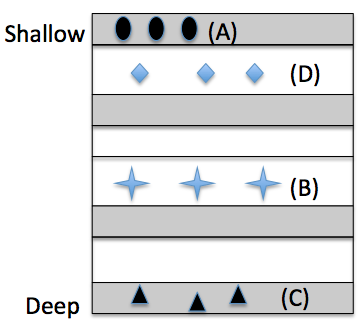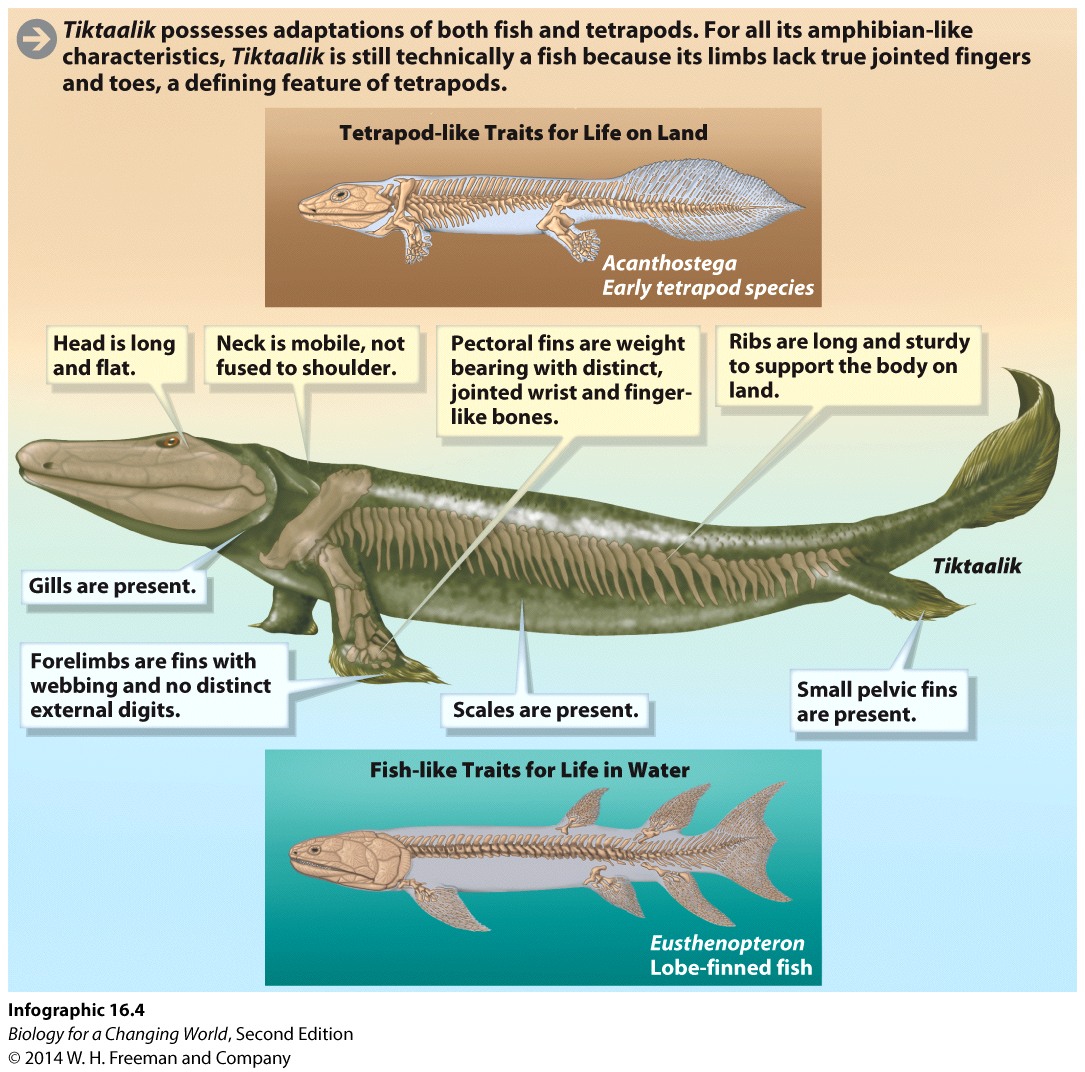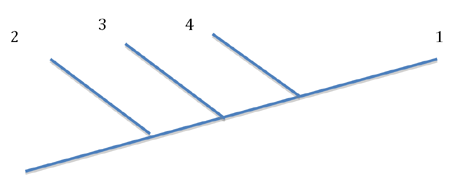Chapter 1. Chapter 16: Evidence for Evolution
1.1 Introduction


Welcome to the Interactive Study Guide for Chapter 16: Evidence for Evolution! This Study Guide will help you master your understanding of the chapter's Driving Questions, using interactive Infographics and activities, as well as targeted assessment questions. Click "Next" to get started, or select a Driving Question from the drop-down menu to the right.
A Fish with Fingers?
A transitional fossil fills a gap in our knowledge of evolution
DRIVING QUESTIONS
- How does the fossil record reveal information about evolutionary changes?
- What features make Tiktaalik a transitional fossil and what role do these types of fossils play in the fossil record?
- What can anatomy and DNA reveal about evolution?
1.2 Driving Question 1
Driving Question 1
How does the fossil record reveal information about evolutionary changes?
Why should you care?
The fossil record is our most tangible evidence of the history of life on earth. Because fossils can only form under a limited set of specific conditions, the record will always be incomplete. Nonetheless, significant new discoveries are being made every year, allowing us to reconstruct the evolutionary histories of everything from plants to whales with increasing precision and accuracy.
The fossil record includes some of our strongest evidence for Darwin’s theory of descent with modification. This theory proposes two things: that all organisms descended from a single common ancestor, and that organisms have changed over time. Both patterns are evident in the fossil record. Further support for Darwin’s theory comes from the fact that we can use our understanding of the fossil record to develop and test evolutionary hypotheses. Their knowledge of the fossil record of vertebrates allowed Neil Shubin and Ted Daeschler to predict the age and location of the rocks in which they could find fossils intermediate in appearance between fish and tetrapods.
Like any history, the history of life on earth needs a timeline to make sense. Prior to the advent of radiometric dating, geologists and paleontologists could place fossils in sequence from youngest to oldest using a system called relative dating. By the 1950’s, advances in technology allowed scientists to use radiometric dating to determine the actual ages of various kinds of rocks. In combination, these two approaches allow scientists to determine with increasing accuracy the ages of fossils like the one of Tiktaalik.
What should you know?
To fully answer this Driving Question, you should be able to:
- Describe the various types of fossils and the unique circumstances under which they can form.
- List and describe conditions that will prevent fossilization from occurring.
- Predict the kinds of organisms that are most likely and least likely to be preserved as fossils.
- Explain how fossils can illustrate the lineage between an ancestor species to its modified, present-day descendants.
- Compare and contrast relative and radiometric dating.
- Interpret a fossil record using a combination of relative and radiometric dating to correctly order and date the fossils it contains.
Infographic Focus
The infographics most pertinent to the Driving Question are 16.1, 16.2 and 16.3.
Question Test Your Vocabulary
Choose the correct term for each of the following definitions:
| Term | Definition |
|---|---|
| YTD/zBNRWTA8PVYack9nGCjWPWg3qCb/bgVx39M/9Gjx4JNabnGGTLxWUwdM/DRCnI7mAb++Jke/Udpb+3x1HVWaInsUSvAfjZcXdnPXOWc2YT+7v0ukGvrgT/4SJ1XkXDb0IsmKjo+2cp4kqOh68uJPb7c= | A scientist who studies ancient life by examining the fossil record. |
| m/27r0CgQKjZ4qrAiqMNrIhbZLOcOLNxLNvmsLnq4RD0Kt0ZF1ItvozutM0DFSwUnfYpg1y6ciz9CSvDD9EKLFoQd1bV6An4MCamNSWMIE0X2kMuF5VfN9EZRnFthJVAsJfa5f8IFcPxd34At+VNbs+qGDQ= | The preserved remains or impressions of once-living organisms. |
| MERT1zbjkUBAnGXNsp0ZtLJN26PoKat/Q77KkdNKzPV1rFt0rqQBTont4/LY5HhX24UvaUhtdjo1gbOKEAYfPN3N2wiq0LVB4AWqToU19Q1zEvMuvtKUs+/cpGmQrCa2VVf3hRyPrUrkvauDLff73SE1v6o= | Determining the age of a fossil from its position relative to layers of rock or fossils of known age. |
| Tw1J3/vXVzyvUDXh9hmyFZzXk+lPlMHEj1JkxX6iQPJ0Wyx++bF3OyDsJbhcSlYU5jj6u6aJYolLcvFyc6WTenF0HmF8AWN+aH2SrijBh2e+6ce/P/WWIZcdKKoFg3lb88Fl5B8OWOVdidZGKpgCOFGLpAY= | An animal with a bony or cartilaginous backbone. |
| b9w4zw2dK4kOBerH/j72Utn+zvnQyiERhFNVwkXajeKM5G20jMBXjmW/eGAYC1q6jWIEQsEWO6UbxNO+SuZr02BdJPt2fkqvscichrRsq1ByMJS1I4Pp0ofTu4m0iK9XCw0PLZZxVcQV6xPs/sfhjR2WAtw= | An assemblage of fossils arranged in order of age, providing evidence of changes in species over time. |
| 7hkusXUihgH3J2qQFN1RPvEtC9k3NHy1mYaDH64k2SLqqMxQblzrysDpyni0RFaWbUWsg+CDapCXnFNNe7VtjIpaDC0TCcgAm5cWJ/kUshMj98DN4uef3jy5+JLQsroZrdvz/3nx3Mqe23eDd8VxJIM3EzY= | Darwin’s term for evolution, combining the ideas that all living things are related and that organisms have changed over time. |
| 1PinTqbZFLmJQoYahW8wzrs0Wf9quniIzu8uYfC+XXm9eXtjDgF2/stMaRou6n/LenQxECyjdRPFPsZR8/MVhQfXciFr8iLuTOGhzv62NZYQSuBYH+353DHu+TN0h8kvyNciKS9Hszez5nPVINdlfNCTRHg= | The use of radioactive isotopes as a measure for determining the age of rock or fossil. |
Describe the various types of fossils and the unique circumstances under which they can form.
Question 1.1
Explain the likely process of fossilization for each of these organisms:
kP9ChNzCt/Za8ltcuGGfJA==Question 1.2
zf2iyZmcSwB9XYz0Question 1.3
x4w8gdZQxPDIsB5efuLVKw==List and describe conditions that will prevent fossilization.
Question 1.4
QvlhhZ9zRO6jSOg1ccR0QpT2WutD1IvjoSYa7IyI2dqaxkLnJDTvQg4q6ws6jDM3+1G4F3+TnptUS0E6GsF9cnFM0ix2bhMCXqf1/+EIoGbCu6r7/vKFfZ3ATm1Q9z+ETdlFG6mLMNk0jEe09vxAzXxj2L7Y38dyFHrSg+KeShZr2vJ/4UH2tjFRFnVzPeSUPddI9VrcotDOtZ6EFlIiVmvZ7pI=It is more likely that conditions preventing the formation of fossils would occur. To make a fossil, especially a good one, a lot of specific conditions must occur at the right time, as described previously. Fossilization is especially difficult in organisms that are made up of soft tissue, since they have to be encased in amber or frozen or dried out very quickly. Also, the likelihood of an organism being covered in sediment quickly, before it is eaten or broken down, is very low.
What kinds of organisms are most likely and least likely to be preserved as fossils?
Question 1.5
r7sdd45ntBSbQGMyiLOhpOBezFjJcgdPbWbWwWrzZWXjauypBPuoFeoiA5ha++vXOYIs34eviAqnbfL8ZfVOKfcYHRWjEM1piLY361NhLZ8xRejC2hbBjGyS2HaYSCneQ0S2wdPvy/Z6HXKBn/DPngn3rK2WHh1Kbmtb3Ml+VdN6LlQlWWMuglgiRbZFwtLqdAKxVYDc+e8=Explain how fossils can illustrate the lineage between an ancestor species and its modified present-day descendants.
Question 1.6
EIermEALiYL6UuCj9YXdp8nNWBrpyIfTv/zU2MqFIpEWcm6YZU5UXhLaVvJdqyMaxqcQ72RhMxbUN0Mw2cGrGR5VsHYYhmUw5nhepX29kxazhlr0d8QUDbq5BhI=Compare and contrast relative and radiometric dating.
Question 1.7
Compare and contrast relative and radiometric dating by filling in the table:
| Relative Dating (Yes/No) | Radiometric Dating (Yes/No) | |
| Can arrange fossils in the correct sequence from oldest to youngest | rIR8DGAY92l8ZwzK | rIR8DGAY92l8ZwzK |
| Can provide an estimate of the absolute age of the fossils | 91jqmClv1tO6X0dB | rIR8DGAY92l8ZwzK |
| Can be used on all fossils regardless of the type of rock in which they are found | rIR8DGAY92l8ZwzK | 91jqmClv1tO6X0dB |
Interpret a fossil record using a combination of relative and radiometric dating to order and date the fossils it contains.
Question 1.8

Question 1.9

Review Questions
Question 1.10
s4KjbPxEz8JBApK1XVHA3IW7gP+2hHq/g7v7go0nXy1nYDMXqo5QGQiYBx3nPQwwlaq1xx0gXTF+H8nn0a6IHBEbKb/YzWatf1xWK5HNwq76ZeK3bk7XpIo2S8C2g04B/6n5KxAU4jj9+kmKEgsjsPyE4BF0ag6TKQq7u2MZjdBoKoYg+c6L94AcZwtgya8GHRhHvC0Pzx+beDpM9whVu+LS7H81j6gi0kXF93eKirQ=Question 1.11
fWRbJYt5VdXFboO4XHrJdlKXoOkn3l5jcF6gp8cEnuAc6987DTPAdMzMw4W6OA1SVDvq2i6Oz3JH+U7+kZi8bZZ39K8fkbXi9CFLnbgj9d0NuKpk9fmqmvF9ObOuQadlatP+QNHFWk9TCBirGSI3Q2XgErTceqOpinh5IPnjlOHA4ktDSSJWat4qKPhFJMkP6wQMg739Ts9GpSw0rNrIBAwadf/C5bz9rXQ6l2KOMNDk406bdkjzHLLy62HIXZY2Question 1.12
uFs2mzGBMCdOnvl0V3q30099HP4LpYeXWy/QLWSoQZmnglJ1R/Cq+SYjeiiZ3xpR7xGOiJx7by1QtXCOlOyds0JYIwLDPWNcrLb+7vneNya1dsNBaER/aV62wTYTqAmtUmFiv+xyEV218TUH3/FG1HtdZ2Uio51sZUTEA1+BQELcOapsIYx9ZnywzJSAIfaiVUQVCo8U+/GWAAluH1aXIOE4jTO75yW8Rj03R1dR8Ktg4FIWlX1Wj9dE/NlqHkJh1.3 Driving Question 2
Driving Question 2
What features make Tiktaalik a transitional fossil, and what role do these types of fossils play in the fossil record?
Why should you care?
The concept of intermediate fossils is widely misunderstood among non-biologists, who often believe that each characteristic of an “intermediate” should be a blend of structures found in earlier and later organisms. Instead, as predicted by descent with modification, an intermediate organism possesses some “old” traits (those found in its ancestors) and some “new” traits (that will be found in its descendants). Tiktaalik is a perfect example of this kind of organism. Not only is it one of many pieces of evidence supporting descent with modification, but it also allows us to understand a crucial stage in our own evolution.
What should you know?
To fully answer this Driving Question, you should be able to:
- Illustrate and discuss the concept of intermediate or transitional fossils using Tiktaalik as an example.
- Explain why transitional or intermediate fossils like that of Tiktaalik are so important for the study of evolution.
Infographic Focus
The infographics most pertinent to the Driving Question are 16.4 and 16.5.
Question Test Your Vocabulary
Choose the correct term for each of the following definitions:
| Term | Definition |
|---|---|
| OZmZOCWo304yOXqISJhvgL3jlkaZUrbiK8g4dg== | A vertebrate animal with four true limbs, that is, jointed, bony appendages with digits. Mammals, amphibians, birds and reptiles are tetrapods. |
| BBe4Pgk0uu9TchGodxEnIus4uG2IrA5FilXWnQ== | An animal without a backbone. |
Illustrate and discuss the concept of intermediate, or transitional, fossils, using Tiktaalik as an example.
Question 1.13
The graphic that follows illustrates some of the traits Tiktaalik shares with its fish ancestors and some it shares with its tetrapod descendants. In the boxes provided, correctly label each trait with a brief description of the trait and whether it represents an ancestral (fishlike) or novel (tetrapod-like) trait.

Explain why transitional or intermediate fossils like that of Tiktaalik are so important for the study of evolution.
Question 1.14
G5iP+atihl8n/q1XLgDLbEPxG0FBenGMSg+kpQJy71vW4QssvZrNge+h06N+XkTgqH1l8o2ZPcXfCIYmia9HPo54GsXALoN1izSmtb1PgN6jY8+cizqIrIKqLmq4s58huVZNpNwEHzPdJGObcyGhVpiXhUFLIsPFhuv+HcIIcnfaf8nplhyL6YppirVr2Wk8Review Questions
Question 1.15
s3CiTuuTsgxe4vvNobVgPXDzXNrrhBmqIJ+Z5tRkVRAa265d/6NqbIBOwNJtJa9xvS39wZEkWsD2UGoRwpdORTVJR6+Y6mMk2JLPY/MeunToEhLLoXyBdqWRtYA0E5KTFIbAmje4MRXPp1bkwVvlQ77NCPxegJtL2Y7FAI4RNPeD+hBtUzHR3Q==Question 1.16
hkOdPct9etE1aSyiGgzz2cZFsnf0vpzsNQZigW6QhOJsVAxhEmCqrRfT8uhGzLaT6WHP4lgVUda2BNPb0wc2MBBDnb/tcuIYBUWsSFpWlq4DKq3pn/g5kAcBLJ35g/GD7qejYmnMFzLhqv+X9wqQZJgSbWQeCKiylmxEzCQkS9E1fSxPmHsSQhULyGvo5PPujwPE7H0lUgkyX+aZhoyzl8x39tq159S4CZ7HkyLme29y2HasefqTs0IXfiwBHHJMySXDJqzW4B8DKipgoqHDKIQGbg5sk3SyWtfzCJ09Q36yDB1AezuezFeKX7V5v3ZHr60iFbsn5bYEGECDmux3qEe3IQdxc3bgON9J5du2Q3JbZJ2o70/0e6g1u1eKqXIQEkb1riHboairMGqdlQen7cliq7dg5KSoMxMfWvRYZUmuX85oK9mDlf3P4ACm12p0KUiHkyUxyDiJq4W3wMIDVs0Iw9MkOo+9XHXGzv3UctojTaQfUCM4U8K/vA/zcuM4t4sB+8LfBNT1gaPk1/Q/EczLvQh0iaoesdVjtfX9QJ42hDqu1.4 Driving Question 3
Driving Question 3
What can anatomy and DNA reveal about evolution?
Why should you care?
Well before Darwin, comparative anatomists noted deep similarities in anatomical structures of very different kinds of organisms. Although they were able to document many examples of what Sir Richard Owen coined “homology,” they were unable to agree on a satisfactory explanation. Darwin recognized that his hypothesis of descent with modification explained this phenomenon perfectly. In fact, he used extensive discussions of homology in a variety of organisms to support his argument in On the Origin of Species. Today, homologies are used to help us determine patterns of relationship among organisms, both living and extinct.
Developmental homologies have fascinated biologists since at least the 1800’s. As evidence for descent with modification, they are important in two ways. First, they are simply more examples of the same phenomenon of homology observed in vertebrate forelimbs. So we can, for example, point to the presence of pharyngeal pouches – which develop into gill slits in fish but not in mammals – as examples of underlying structural similarity in seemingly disparate organisms. Second, by tracing the development of the same embryological structure in distantly related organisms, we have discovered unexpected homologies, such as that between our middle ear bones and reptilian jaw bones.
DNA sequence information provides yet more evidence for descent with modification. It is another example of homology and, due to the way it changes over time, we can use it as a powerful tool to help us understand patterns of relationship among organisms. Increasingly, we are even able to identify specific changes in DNA that are related to specific traits of organisms, enabling us to understand how natural selection has modified organisms over time.
What should you know?
To fully answer this Driving Question, you should be able to:
- Define and illustrate the concept of homology using the vertebrate forelimb as an example.
- Explain why vertebrate forelimbs are so different in spite of their underlying structural similarity.
- Explain the significance of developmental homologies to our understanding of descent with modification.
- Illustrate and explain how DNA sequences are examples of homology between organisms.
- Illustrate and explain how the level of DNA sequence similarity between organisms reveals their relationship through evolution.
Infographic Focus
The infographics most pertinent to the Driving Question are 16.5, 16.6 and 16.7.
Question Test Your Vocabulary
Choose the correct term for each of the following definitions:
| Term | Definition |
|---|---|
| H+UvfClh24kTAC7yPd24S7UrIIVi7fBCTKkjAnFATapKzS7n | Anatomical, genetic or developmental similarity among organisms due to common ancestry. |
| h9TOTmaUj9Nlowuvz0Dp4h+ezUcHwDIcCpKMCD3Y4j0t9i9o | A structure inherited from an ancestor that no longer serves a clear function in the organism that possesses it. |
Define and illustrate the concept of homology using the vertebrate forelimb as an example.
Question 1.17
List and describe the structural and functional features common to the forelimbs in the following pairs of organisms:
wzYOoeANAKNVkp+YpTxEOyYRGFoPW825AQWLnoIUWq3O9QoBy7IaUcSYj7U=Question 1.18
5QnoOZENd7aEFLYsfv8C2xx3XK/llOs8y+LEykboYYEK++3QvKzAWcmWGU4=Question 1.19
soyUwhAVHZRESkSWrrCqz+Splla/9FLr4yPH7Q==Question 1.20
q5BzqWqEKzgM9E9J525qMHcYnFA=Question 1.21
VZ3lFswFlc4EJuWhH8pAo8BsI7F/2oQo1OMd+Qbz5v+osbaR5WuSVCxnRQuuaa9EyTl/qY18yBZryMZu582H7VW+4RgV83O8Question 1.22
MX/npiic/iooBNVGiQM47koH2MSLdRIwhJJ7T0OLXV8TUu8MfuDtk+Tjkc9Cx4q1E/12+tOi13ySAtJHiYp29+j2goA=Explain why vertebrate forelimbs are so different in spite of their underlying structural similarity.
Question 1.23

Explain the significance of developmental homologies to our understanding of descent with modification.
Question 1.24
QvrhbPzGABP7yDiLjDmDn6eMMIYDflkkpXv27O64q4Q2P3kYO8RlISJuiVjtLV6+3FzuQ9MqiiYIrpxlrvJkzE6ezPQtgdSs7YHKOcSqrS1XMaDPcILfQXrvQUa6kom47vvRYQ==Question 1.25
/M2gHRjinOTroS66AAXlqeZIJqv62QBhbPFQN6ReEp9AVQyFbKWTqPi6rWmaNV+NWpw82jeEFmVJIJtJ5WHV0T0/qRTCjTtp/ExVhXXW3WtK2i9Tq+mLu7YC01kBcBdApxExGXGr4i31lFs/IDMaEDoGYr5g6GgW0cUAEL373mo=Illustrate and explain how DNA sequences are examples of homology between organisms.
Question 1.26
JPwdpxOckKY8EK9y83MMelaXFXU7sjdj3n7LYp6VuOMk3mQO7rObDpzYKLAjK7+4Fv4+dcLZgxGfb5RJAVzu0hqfIFbgUwIbtVVGCQgW3nhntW5gpz/PNDjwUdsriaJyeLsio8soL65MZBm119M69tsMfJnw1r2yprTlkG+txS0O0MnGacgtcgtatctgaacatacggctagctaaggtacctcgttgctacagtc (two changes)
Question 1.27
2UGyVAD6jND7gkdDrMMzXUTdJ21rrmXLpF+ludGmyJn7qZSp/L/CFx0sSyl1zVSevU+L0kvxWafQJbrmrc1OWMsFNCRtIb0s9sHzAS+ySQhMhQZ7uQST1a+/fKDtYtUUiqPLec9+PYSqwUvqli1VxDqrT5vZivxGQ5ZrTIPBk6I=Question 1.28
azevHVMmg4Mvr/vf4VjTBcjysFHNP6qKZygNqvQu3tOuxE+kH0KhucTKy+J1LIQIfmRvrvD9icy1IQdOmS+pBpYgYfte0SpNFNUra8pLEFg9gVEjEZJgKJGXRc7NgD3JmuHbLa/wsmeSu8MaGaMNfYuXp3SrEj5rw8Qdo0h6GEeSowFAx7lr8Z3cQHU=Illustrate and explain how the level of DNA sequence similarity between organisms reveals their relationship through evolution.
Question 1.29

This diagram represents a DNA sequence taken from the same part of the same gene in four different organisms.
ZZH9cDlBLFVhfoAsSMjrVmWHAO3LliSJBY1vQvdiFLtRoXWEwu/2636/SmHSOiFLOWTbaVIAkryZUZ9+lPylTek9m0ySMO4hB6XKaywVkF49YKxlND4sxp3fuvjgLx4kYOiBFLNgI1ZTnVbngqmSEVYkakaOfYdHwLoPk6st8phAua9akM1WMoCwM9xGeOnwLRGieGsnPe26sTK6FCKnVq5fYSoFQRkmg7nltdlJ8mXCx/6WW1G7d8AjDot4uSYLkN3b2kaJdUMhkJHL9I2ilt+hOyDtyUDebCpeN5RQgU44vClzHzpf2o0bQMih5AKIQNGDVY20FchD8/b+tdkNg1ibN+EeB+RqjidmJLRiErMck9GK2D1dYFr3NX+9dPgDtOxFwJUdkVtEPna2UQhlmUWPpM/EAzVoreRKew+dDXDo783jgZKYV2fhtH7Wt23AEhGx/JiPechYrZTgSequence 3: 5 / 30 = 0.167 * 100 = 16.7; 100 – 16.7 = 83.3% similar to 1
Sequence 4: 3 / 30 = 0.10 * 100 = 10; 100 – 10 = 90% similar to 1
Question 1.30
LZjy6Zen5JG8vfN2B8QmqklEEDcTtAtTKu5JGOS3VFL5VE2k2jphRH6mOGeKfaH6DVaxbbGsDFiHWBQEUgjMV2Qwst+qqCkbKsrahnm0Kfiv9Qh/v32y/N7/ofVxYVdGZImZJGGQkqJ+HQH3bMfVWQ==Question 1.31
t9kJ3D6QSsc54oceNTfEXxHK/lEiY/O/CfNfLh4BLUjY37PIWtkgai4eFNTOCbOiqgsgxrohBp5FTn1GMf8qB7li16nZTsPRLmM9/KfV6vdWGpFgDtAwi5g+ugh6oNMhXpTOcw3iVsPVA7K2Qdh2Kg49UmsIy6hKEdAoRTcoeI91W7Uv8Nw91EgnfZXaba8uTrA4GQlDsa2FoXMNTocJSMhFicE=
Review Questions